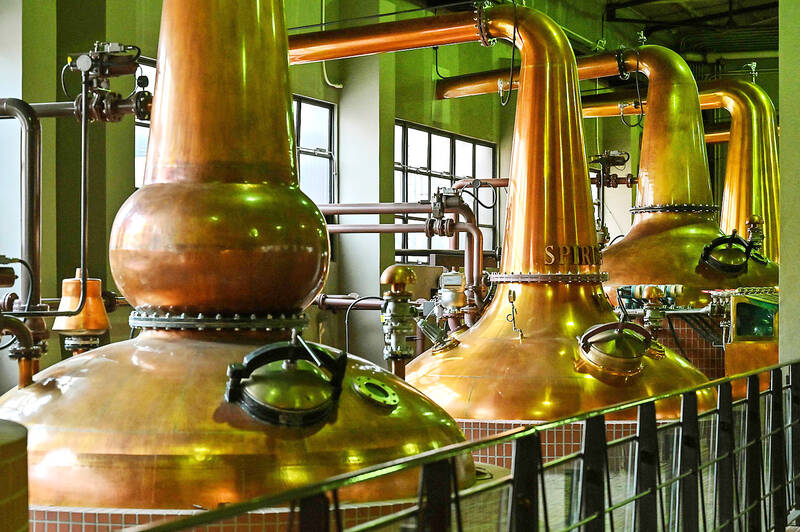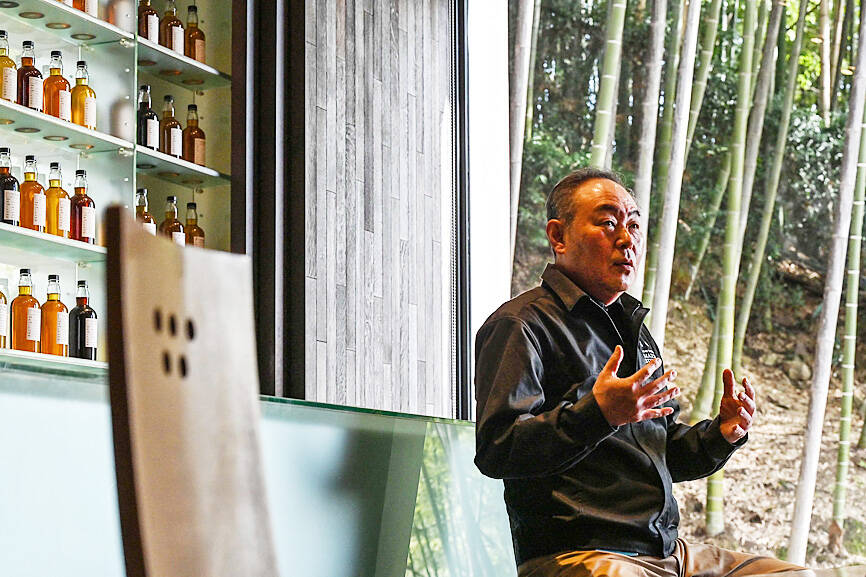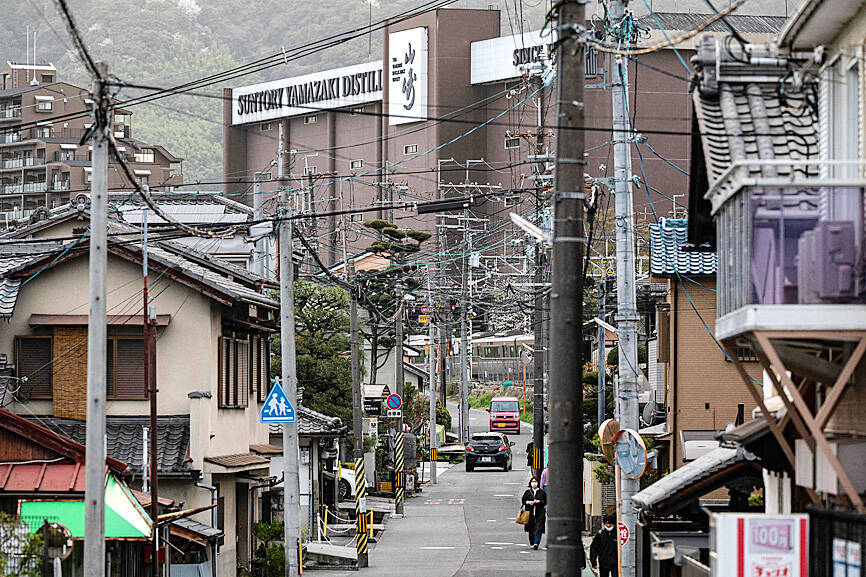The famed Yamazaki Distillery marks its 100th anniversary this year with plenty to celebrate, as Japan’s acclaimed aged whiskeys command increasingly eye-watering prices thanks to growing demand and longstanding shortages.
Japan’s oldest distillery has sat at the foot of a mountain outside Kyoto since it was built by Shinjiro Torii, the founder of Yamazaki maker Suntory, who wanted to make whiskey suited to a Japanese palate.
It is largely foreign demand, along with the relative scarcity of the most desirable decades-old bottles, that has pushed prices sky-high.

Photo: AFP
A bottle of Yamazaki 55, with an official retail price of ¥3 million (US$21,156), sold for US$600,000 at a Sotheby’s auction in New York last year. That was still well below the record US$795,000 set at a Hong Kong auction in 2020.
And in Japan’s upscale Ginza district, a more modest Yamazaki 18 with a manufacturer’s price of ¥32,000 is on sale for ¥120,000.
Suntory does not disclose production volume, but the distillery’s senior general manager Takahisa Fujii said it has risen dramatically over the past 20 years.

Photo: AFP
Warning: Excessive consumption of alcohol can damage your health
The company announced plans this year to pump ¥10 billion into its Yamazaki and Hakushu distilleries, but demand still far outstrips capacity.
“We have received so many requests for our whiskey from customers around the world, so we are trying to respond to them as best we can,” Fujii said.
The Yamazaki Distillery welcomes dozens of visitors from Japan and abroad each day, but those hoping to stock up on aged varieties come away disappointed.

Photo: AFP
Peter Kaleta, a 35-year-old visitor who runs a bar in Poland, was crestfallen after he could not buy one of his favorites.
It is a “must-have” for whiskey bars, he added, calling the lack of aged varieties “kind of depressing.”
Junpei Kusunoki, manager of Tokyo Whiskey Library, a bar in the chic Omotesando district, is no stranger to the struggle for supply.
“The whiskey boom is back,” he said. “There’s a quota in Omotesando area, so it’s a war against competitors. We’re trying everything to rake in” bottles.
The location of Yamazaki’s distillery is a world away from the Scottish terroir most associated with whiskey, but Fujii says the site was chosen for the region’s famed water.
Its renown traces back to the 16th century, when Japanese tea master Sen no Rikyu labored nearby.
“You can’t make good liquor without good water,” Fujii said, adding that the humid and misty environment helps age the whiskey.
The distillery’s unique range of copper stills in different shapes and sizes also contribute to the brand’s particular profile, he said.
Yamazaki’s layered and well-balanced flavors are considered a good match for Japanese cuisine, Fujii said.
There are now around 100 distilleries across Japan, according to whiskey critic Mamoru Tsuchiya, with a reputation for quality helping boost the profile of its tipples.
The exorbitant prices are the result of a “lack of whiskey at a time when demand from abroad has increased exponentially,” he said.
Today’s success belies a 20-year downturn after domestic consumption peaked in 1983.
“Sales were declining every year, so the impact was big,” said Nobuyuki Akiyama, head of Suntory’s whiskey marketing division.
Things only started to turn around in the early 2000s, when Nikka Whiskey’s Yoichi 10 and Yamazaki 12 received prestigious international industry awards.
And 2003 saw Suntory’s Hibiki 17 play a starring role in the hit movie Lost in Translation, featuring Bill Murray promoting the drink with the line: “For relaxing times, make it Suntory time.”
Domestic sales also recovered just as international demand began to rise, thanks in part to the revival of highballs, a mix of whiskey and soda.
A 2015 television drama based on the life of Nikka Whiskey’s founder also helped drive renewed domestic interest.
The sudden uptick came too quickly for companies that have to plan production decades in advance.
“We have Hibiki 30, for example, where we need to think about how many bottles we should make 30 years into the future,” said Akiyama, adding it was “impossible” to predict the market so far in advance.
For now, sales look likely to continue growing, with exports surging to ¥56 billion last year, 14 times more than a decade earlier.
Judith Ly, a German visitor to the Yamazaki Distillery, said she makes an exception for Japanese whiskey.
“Normally I don’t drink whiskey, but I like the taste,” she said. “It’s smooth. It’s easy to drink.”

MULTIFACETED: A task force has analyzed possible scenarios and created responses to assist domestic industries in dealing with US tariffs, the economics minister said The Executive Yuan is tomorrow to announce countermeasures to US President Donald Trump’s planned reciprocal tariffs, although the details of the plan would not be made public until Monday next week, Minister of Economic Affairs J.W. Kuo (郭智輝) said yesterday. The Cabinet established an economic and trade task force in November last year to deal with US trade and tariff related issues, Kuo told reporters outside the legislature in Taipei. The task force has been analyzing and evaluating all kinds of scenarios to identify suitable responses and determine how best to assist domestic industries in managing the effects of Trump’s tariffs, he

TIGHT-LIPPED: UMC said it had no merger plans at the moment, after Nikkei Asia reported that the firm and GlobalFoundries were considering restarting merger talks United Microelectronics Corp (UMC, 聯電), the world’s No. 4 contract chipmaker, yesterday launched a new US$5 billion 12-inch chip factory in Singapore as part of its latest effort to diversify its manufacturing footprint amid growing geopolitical risks. The new factory, adjacent to UMC’s existing Singapore fab in the Pasir Res Wafer Fab Park, is scheduled to enter volume production next year, utilizing mature 22-nanometer and 28-nanometer process technologies, UMC said in a statement. The company plans to invest US$5 billion during the first phase of the new fab, which would have an installed capacity of 30,000 12-inch wafers per month, it said. The

Taiwan’s official purchasing managers’ index (PMI) last month rose 0.2 percentage points to 54.2, in a second consecutive month of expansion, thanks to front-loading demand intended to avoid potential US tariff hikes, the Chung-Hua Institution for Economic Research (CIER, 中華經濟研究院) said yesterday. While short-term demand appeared robust, uncertainties rose due to US President Donald Trump’s unpredictable trade policy, CIER president Lien Hsien-ming (連賢明) told a news conference in Taipei. Taiwan’s economy this year would be characterized by high-level fluctuations and the volatility would be wilder than most expect, Lien said Demand for electronics, particularly semiconductors, continues to benefit from US technology giants’ effort

‘SWASTICAR’: Tesla CEO Elon Musk’s close association with Donald Trump has prompted opponents to brand him a ‘Nazi’ and resulted in a dramatic drop in sales Demonstrators descended on Tesla Inc dealerships across the US, and in Europe and Canada on Saturday to protest company chief Elon Musk, who has amassed extraordinary power as a top adviser to US President Donald Trump. Waving signs with messages such as “Musk is stealing our money” and “Reclaim our country,” the protests largely took place peacefully following fiery episodes of vandalism on Tesla vehicles, dealerships and other facilities in recent weeks that US officials have denounced as terrorism. Hundreds rallied on Saturday outside the Tesla dealership in Manhattan. Some blasted Musk, the world’s richest man, while others demanded the shuttering of his